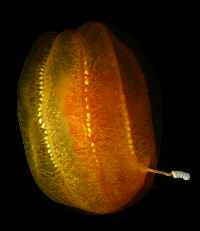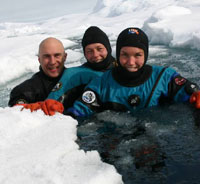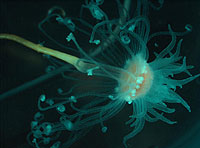 Diversity of species 'much higher' than expected by Doug Schneider July 29, 2005
"We believe we have found perhaps seven new species," said Rolf Gradinger, a marine scientist at the UAF School of Fisheries and Ocean Sciences, and the expedition's chief scientist. "Not just species new to us, but new to science. We found more species than we expected and different species than we expected." Among the new species discovered is a previously unknown type of jellyfish. The cone-shaped jelly is orange and appears to have ridges running the length of its soft body. "It's something scientists hadn't seen before," said Gradinger. "It was pretty emotional for us, because we may be the first people on earth to see it." The month-long cruise explored the Canadian Basin, a vast region northeast of Alaska in the Arctic Ocean. Scientists used remotely operated vehicles equipped with specialized collection devices to capture marine organisms in waters as deep as 11,000 feet. High definition television was also employed to videotape species in their natural environment. "From my perspective the highlight of the expedition was being able to see the fascinating colors and movement of the animals," said Gradinger. UAF marine scientist Bodil Bluhm said her research team discovered what they believe are three new species of marine polychaete worms, and five worm species that had not been previously documented in the Canadian Basin. "They look a bit like the worms we find in our gardens," said Bluhm. "But these worms are different in that they can live on the limited food that settles at these extreme depths." Scientists also found pelagic snails, feather stars, sea cucumbers, sea anemones, bristle stars and other species in great abundance. "The densities were much higher than we expected," said UAF marine scientist Russ Hopcroft. "What continues to fascinate and motivate us all is the chance to record species never known before, to accurately map their range and understand their rapidly-changing habitat." Bluhm said it will take months to sort through the samples and properly identify the hundreds of organisms collected. Scientists have long believed that species biodiversity is reduced in areas closer to the poles. But scientists say that may be because they haven't been able to look for marine life in the deep Arctic seas. "But with the high-tech tools we have now, I think for some groups of animals we can say that the species diversity is extensive even at these high latitudes," said Bluhm. Twenty-four scientists from the United States, Canada, Russia, and China explored the Canadian Basin from the sea ice through the water column to the seafloor. The expedition, aboard the United States Coast Guard icebreaker Healy, was funded by the NOAA Ocean Exploration Program. The research will contribute to the Census of Marine Life, a ten-year, $1 billion project funded by government and private donors. "The major thing we should all be proud of is that we sampled from 14 stations in up to 11, 000 feet of water covered by sea ice," said Bluhm. "That's the operational success we needed to make these important scientific discoveries." UAF researchers who took part
in the expedition include Drs. Rolf Gradinger, Bodil Bluhm, Russ
Hopcroft, Terry Whitledge, Dean Stockwell, and Katrin Iken. UAF
graduate students include: Elisabeth Calvert, Shawn Harper, and
Mette Nielson. UAF research technicians include: Brenda Holiday
and Sarah Thornton.
On the Web:
Publish A Letter on SitNews Read Letters/Opinions Submit A Letter to the Editor
|
||


